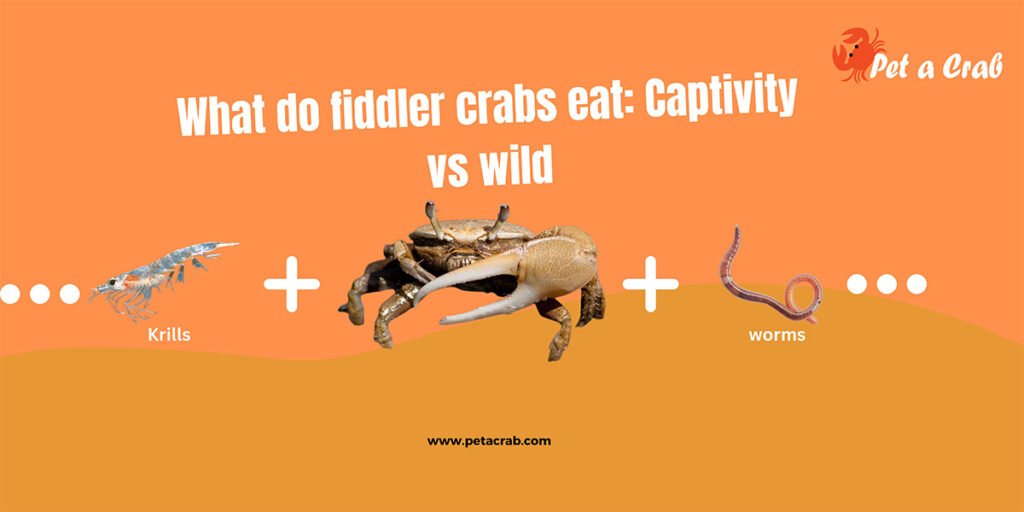Hermit crabs can be a great choice for aquariums. But many times we get different problems and different shell-related questions, like, why is my hermit crab out of its shell and not moving?
Let’s diagnose your pet crab.
Why is my hermit crab out of its shell and not moving?
If your crab is not moving and it smells rotten there is a high chance it is dead. But don’t be confused with molting. During the molting process hermit crabs shed their exoskeletons. They will look weak, confused-looking eyeballs, and the color will look less vibrant and become immobile for a short period of time.

Reasons for not moving
Health concern
Unlike other crabs hermit crabs have very vulnerable abdomens. Transporting or other stressors can cause physical damage to the soft body. Which may be the cause of not moving a hermit crab.
Molting period
Every time they go through the molting process, they become weak, and lethargic and can stop moving for a while. This is the scenario in most cases.
Sudden movement
It’s like moving from one school to another will make you shy, uncomfortable, and silent. The same goes for the hermit crab. Adapting to a new habitat, animals, temperature, and overall environment can take some time. They like to play around in secure and familiar environments. Moving them to a new environment can disrupt their established territories and social hierarchies which can lead to stress.
Stress
Sudden movement and changes in the environment can be stressful for them. Stress can weaken their immune system, making them more susceptible to illness.
What you can do to help a molting hermit crab
Molting is a natural but a bit vulnerable process for hermit crabs. Here are some advice to follow.
- 1. Provide privacy: Isolate the crab for the going through the process. Keep it where they won’t get disturbed or feared by predators. If isolation is not necessary a hiding chamber can be created carefully.
- 2. Maintain proper humidity: Hermit crabs need a humid environment, especially in the molting period. Ensure the substrate in their habitat is moist. A proper helping humidity level during the molting period is around 70-80%.
- 3. Temperature Stability: Ensure the temperature in the habitat is 75°F to 85°F (24°C to 29°C).
- 4. Provide Calcium-Rich Foods: Calcium-rich food helps their new exoskeleton. Give them calcium-rich foods like cuttlebone, eggshells, or commercial crab foods that contain calcium.
- 5. Monitor Health: If you notice any abnormalities or any sign of illness consult with a veterinarian experienced in hermit crab care.
- 6. Maintain a Clean Environment: A clean habitat is crucial for the health of molting hermit crabs. Remove any uneaten food promptly, and ensure that the substrate is free of debris to prevent infections.
What do sick hermit crabs look like?
A sick hermit crab can show many signs of illness. If a hermit crab is inactive or sluggish, it could be a sign of illness. A healthy hermit crab will be curious and active.
Staying outside of the shell for too long and changing the shell repeatedly can be a sign of illness. Shell damage can be a problem. Inspect the shell, if you see any cracks on the shell, change the shell and give it some options with the shell. Otherwise, a damaged shell can be an entry point for infection.
Losing weight or apparent thinning may be a sign of illness or malnutrition. A sudden change in eating habits can be an indicator of illness. Ensure that they have access to a varied and nutritious diet.
Abnormal body posture like hunching over or lying on its side may be an indicator of illness. Also, changes in the color of the exoskeleton can be a cause for concern. Foul or unusual odors emanating from the crab could be a sign of infection or other health issues.
Mucus or fluid discharge from any parts of the body like joints and mouth indicates a health issue. If you notice rapid or labored breathing, it could be a sign of respiratory distress. (Why is my hermit crab out of its shell and not moving?)
How do I know if my hermit crab is stressed?
Fighting each other and aggressive behavior may indicate stress. This occurs when they feel threatened or competition for limited resources. Avoiding any kind of interaction and staying buried for extended periods could be a sign of stress.
Give them enough hiding spots. Ensure they get a well-fitted shell by giving them various choices, especially after molting.

Why is my hermit crab trying to get out of its shell?
It may be they are not feeling comfortable in the shell and trying to change it. Any foreign object like gravel or stone may be bothering them in the shell. Parasites or bacteria can be another cause of getting out of the shell. After molting their size becomes bigger, the old one does not fit much, they need a new shell, maybe that’s why they are out of the shell.
The current shell might be damaged or they might not feel comfortable or safe in the old one, that’s why they are seeking a new one. Any kind of stress can force them to exit the shell.
How do I get my hermit crab to go back into its shell?
Provide suitable shells
Ensure there are several empty, clean shells of different sizes available in the enclosure. You can buy painted shells from local stores or online stores they look better in painted shells. Make sure the pain doesn’t become toxic for the hermit crab.

Maintain suitable environment
Make sure to provide comfortable substrates and enough hiding spots with proper humidity and temperature. Ensure the hiding spot is free from any disturbances.
After doing all of these, sometimes you may have to put it in a shell. Help it to get near a suitable shell, it will get into the shell on its own. If they can’t move or don’t get to the shell you will try to put the hiding part into the shell. But don’t do it if you don’t know how to do this, you may end up damaging their body. They like to fit comfortably on the shell in a unique way.
Shell is an essential thing for a hermit crab. It’s like their body part. So try to put it back into the shell; otherwise, it can’t survive for long. See how long a hermit crab lives without a shell.


